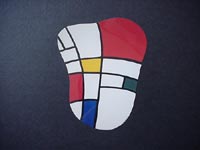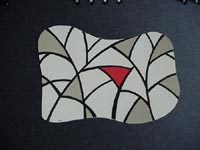 "COMPOSITION IN RED YELLOW, GRAY AND BLUE" "COMPOSITION IN RED YELLOW, GRAY AND BLUE"
90x71cm, 1999 | One of the most difficult challenges in canvas design is what may be called morphistic elementarism - a reference to the works of Piet Mondrian and Jan Van Doesburg.
Mondrian had set out to achieve universal harmony through the most simple elements in painting: Line and colour. Van Doesburg rejected Mondrians rigid vertical-horizontal formula by introducing diagonals. He named it elementarism, while a certain degree of rigidity doubtlessly remaind. With Morphism this rigitity is further reduced, in some cases completely abandoned. This time curviliner lines rather than straights are employed: Mondrians rectilinear purism is thereby transformed into a curvilinear composition of equal clarity and discipline. Thereto, the rectangular picture plane is replaced by a morphistically shaped canvas. The other features, i.e. flat areas boarded by thick, black lines, pure colours, white areas of contrast, etc. remain untouched.
The task is extremely challenging since the result must be of equal harmony and balance. The Morphistic composition is lithe and soft. Any loss in purism is offset by an increase in tension and dynamics. At the same time, if any references to nature are omitted, total abstraction is preserved.
|  "AUTUMN" "AUTUMN"
101x65cm, 1999
|

